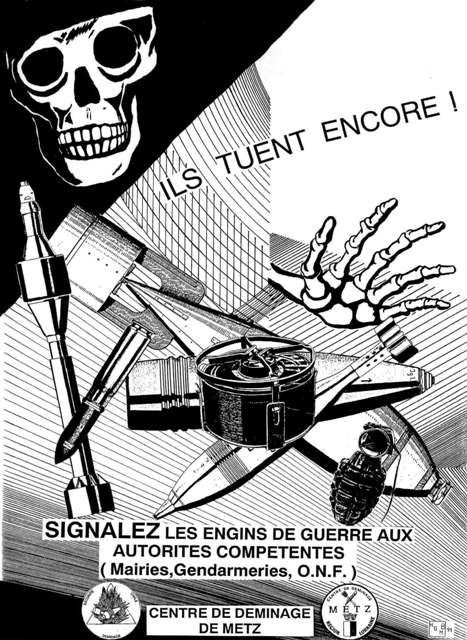Contents
Introduction
The unsettling truths – The battlefields of northern and eastern France – Old weapons kill – Old weapons pollute – Old weapons harm flora and fauna – Chemical weapons
War Remains Inventory from January 1, 2008 to December 31, 2011 with maps:
Franche-Comté Region
Alsace Region
Lorraine Region
Champagne-Ardenne Region
Ile-de-France Region
Picardie Region
Nord – Pas-de-Calais Region
Summary map
Sources
Introduction
War remnants do not have a course. Old weapons kill, pollute, and are the enemies of biodiversity. Following their previous research, Robin des Bois has published a new inventory of weapons discovered in the 7 regions in the north and east of France, casualties of the wars of 1870, 1941-18, and 1939-45.
The inventory covers the years 2008, 2009, 2010, and 2011. It has been realized thanks to the regional press, communications from prefectures, specialized publications, and information from experts.
This history is accompanied by maps, historic commentary, and circumstantial information for each of the 566 discoveries, as well as war propaganda.
The unsettling truths
Robin des Bois’ inventory is not exhaustive. These discoveries are not always the object of press releases or news stories. The public powers do not like to speak of this subject and don’t appreciate a discussion of the truths that unsettle us:
– there is not enough preventative information on the dangers of war remains currently in existence, as evidenced by some of the unbelievable behaviors of discoverers described in the inventory;
– the Civil Security bomb squad is not very large – and instead, they are rerouted to mission s that do not concern them, such as the protection of politicians;
– the Civil Security bomb squad is growing old; because of the lack of moral and financial validation in the face of high risk situations, recruitment is difficult and the apprenticeship, in addition to acquiring the relevant manual and encyclopedic knowledge, takes 10 years ;
– buffer storage sites at the “end of the road”, on farms, or in town hall annexes, waiting several days or weeks for the “bomb squad tour” to visit are commonplace in departments like la Somme, l’Aisne, and le Nord;
– destructions of weapons at discovery sites, in quarries, on military property, and in enclosed spaces regulated by the Classified Installations do not guarantee the safety of people, soil, subsoil, aquatic spaces, fauna, flora, or agricultural production;
– on-site destructions by burial or open-air combustion do not respect the international convention on the prohibition of chemical weapons that has been in force since 1997;
– in terms of regulation, an old abandoned weapon is not considered to be waste; its burning or exploding in open air can be done without an environmental impact report. The Minister of Ecology wants to be done with this practice. The Minister of the Interior and the Minister of Defense, do not want to hear it spoken about. In Germany, when weapons are considered non-transportable, a mobile furnace is brought in, called a “field installation”;
– the dumping of weapons that cannot be disposed of on land without presenting grave risks is authorized by the Environmental Code. The potential prolongation of this prohibited and denounced practice around the world is explained by the technical and obviously financial incapacity of France to equip itself with a factory designed for the destruction of chemical weapons. The SECOIA project, the Site for Elimination and Storage of Identified Ancient Objects, is very different. In the most optimistic of hypotheses, SECOIA could be operational at the end of this decade. Until then, fix it yourself, bury it, and be discrete;
– Robin des Bois has not obtained a response to its letter in May 2003 to the Ministers of Defense, Interior, and Ecology demanding an exhaustive annual public report, including maps, of war remnants that have been retrieved. On the contrary, this information is even less accessible, thanks to an amendment to the 2008 law on the archives. This amendment prohibits the consultation of public documents whose communication could help facilitate the localization of chemical weapons;
– in the regions, the bombarded towns, the rural territories that are slowly urbanizing are historically known as battlefields, construction and excavation permits are given without requirements into potential abandoned war waste that could be present, voluntarily or involuntarily buried;
– clay-pigeon traps or duck-hunting areas are considered sites polluted by gunfire. Curiously, the pollution of battlefields is forgotten or neglected by the public and scientific powers.
The battlefields of northern and eastern France
Each year, in the French territory, 500 to 800 tons of ancient, abandoned, degraded, and unpredictable weapons, more dangerous the longer they sit, are discovered, collected, sorted, and neutralized or stored while waiting for their final destruction. The majority of weapons collected come from the north and the east.
In reading this file, pay attention to where you step. You’re entering the battlefields of the three most recent wars: 1870, 1914-18, and 1939-45. The soldiers used incalculable quantities of innovative, efficient, armor-piercing, insidious, and pollutant weapons. Nord-Pas-de-Calais, Lorraine, Champagne-Ardenne, Ile-de-France, Picardy, Alsace, and Franche-Comté all contain old battlefields. In northern and eastern France, a thousand shells of all calibers, equaling 15 million tons of metal, were fired in World War I. A quarter of these shells did not explode, and 6% contained poison gas. During World War II, 1,700 French towns were bombed. 14% of the English bombs and 16% of the German bombs did not explode, but buried themselves. The majority are 4 meters deep, 20% are 6 meters deep, 10% are 7 meters deep, and 1% are 9 meters deep or more. Ile-de-France also carries scars from the siege of Paris in 1870 – for more on this subject, see Crétil in the Ile-de-France 2008 inventory.
The soil, subsoil, groundwater, rivers, lakes, and canals are all reservoirs that risk containing pollutants from military action.
In the 7 regions of northern and eastern France, 25 million people live and work on a surface stuffed with unexploded or hidden weapons and that has been morphologically deformed by craters, tunnels, erosions, trenches, holes from bombs, and shell-holes. Every year, the sugar refineries gather war weapons, cartridges, grenades, and shells along with their beet harvest – for more on this subject, see Roye in the Picardy November 2010 inventory.
Old weapons kill.
“Each spring, in an area thought to be clean, grenades and shells push back, come out of the ground, and here and there take victims. In times of peace, a shell explosion is called a work accident,” (Pierre Mac Orlan). Yet worse, they are sometimes called errors of manipulation. In April 2007, two Metz Civil Security bomb squad experts were killed in the explosion of a warehouse of old weapons in Ressaincourt. They were handling shells from World War I and II. Two Marseille Civil Security bomb squad experts were very badly injured in a quarry in Vaucluse in May 2012. In pairs of two, they destroyed old and unstable shells and grenades that were recently discovered in Lubéron. Emergency services were not alerted until two hours after the incident, when quarry workers returned from lunch.
Between January 2008 and December 2011, in the 7 regions considered in this new inventory, the 3 deaths and about 30 wounded, poisoned, or examined at the hospital are regrettable.
Old weapons pollute.
Near Verdun, in the oakwood forests, considerable amounts of arsenic were discovered by German university students where chemical shells had been incinerated at La Place à Gaz. Arsenic composites were used by French troops in 1915. They later returned to phosgene compositions, as well as to another chemical weapon compound with a hydrocyanic acid base. Beginning in September 1917, the German troops used arsenic shells. The existence of La Place à Gaz was officially recognized in 2007. Without a doubt, in Lorraine and in other regions, other sites polluted by rudimentary destruction of chemical weapons remain – for more on this subject, see Illzach in the March 2009 Alsace inventory.
Game and vegetable products from the forests affected by war may be polluted by lead or other metals and chemical compounds. There has not been research coordinated or published on this subject.
Chemical weapons are not the only weapons to pollute. In northern France, elevated concentrations of perchlorate salts in tap water are attributed to the diverse effects of weapons buried in the soil. A correlation has been found between the highest contents and the regions most seriously affected by the last two wars. This is notably the case for the conglomerations of Arras, Lens, and Douai. Perchlorate was used as an explosive in German shells. It is a hormone disruptor. Before reaching tap water, perchlorate salts pollute groundwater. The aftereffects of World War I have been forgotten by the Water Framework Directive, whose objective is the preservation and restoration of aquatic resources.
The other degraded and rusty munitions and fragments buried in the soil contain explosives or explosive residues like trinitrotoluene (TNT), dinitronaphthalene, trinitrophenol (TNP), or picric acid. As they degrade, they let toxic, ecotoxic, herbicide, insecticide, biocide, and water soluble substances into the environment. And we can’t forget mercury. A single shell detonator from World War I contains 2 grams of mercury. American experts estimate that 200 dangerous chemical substances could be contained in or created from military weapons.
Old weapons harm flora and fauna.
A hundred years after World War I, the Zone Rouge throughout Verdun (832 km2) remains scarred by broken and dead trees, gunfire, and diverse remains.
Studies on residual pollution and the effects of war on animal and vegetal species in Verdun are rare. The best have come from the Natural History Museum… in Luxembourg. They describe the extinction of salamanders and the increasing rarity and subsequent slow recolonization by newts, toads, frogs, and reptiles. The most mobile species return to the area from surrounding islands where they’d taken refuge.
The same studies, without showing a formal correlation with the use of poison gas during the wars throughout Verdun, notes genetic anomalies and important variations in color in a number of vegetal species. Mustard gas is a mutagen.
Luxembourg naturalists estimate that “the Verdun Zone Rouge is reminiscent of the often cited example of the island of Guam in the Marianas where a dozen endemic bird species had survived the bombings of the island in World War II only to be later decimated after the introduction of the Eastern brown snake from Australia to eliminate rats on the plantations,”. According to them, illegal landfills, stone laid in ruts, the draining of wetlands, resinous tree plantations, and roads that have been eliminated 50 years after World War I are the most interesting sites in terms of recolonization by endemic flora and fauna. The Association des Botanistes Lorrains highlights that the aggressive plants that have arrived in the Verdun Zone Rouge are, in a way, invasive species. The seeds come from horse feed, as well as the packs and sleeping pads of soldiers.
Chemical weapons.
In 1870, the German Chief of Staff dismissed the recommendations of a pharmacist. He had suggested the creation and use of veratrine shells, using a compound of vegetal curare alkaloids that were poisonous, irritating, and paralyzing.
In 1914, the French Minister of War dismissed the advice of a well-known chemist and manufacturer with a scathing reply: “Sir, we are not fighting a war of apothecaries,”.
In 1918, the French production of mustard gas had surpassed that of its use by the artillery. Thus, France became an exporter of mustard gas. It had been led to launching a chemical war and abandoning principles when faced with the German benzyl bromine shells in Argonne in 1915 and the widespread use of mustard gas by the German army in summer 1917, reaching Ypres in Belgium.
During World War I, 112,600 tons of chemical weapons were used. The main countries that used them were, in descending order, Germany, France, and Great Britain.
Today, in 2012, abandoned chemical weapons on old battlefields threaten soil and subsoil, populations, and the environment.
Mustard gas.
This was the worst of chemical weapons used from 1914-18. It is insidious. Its persistent toxic effects arise hours after exposure and only get worse. Just skin contact with clothes or other objects contaminated by mustard gas is enough to prove second or third-degree burns that are difficult to heal. Mustard gas can contaminate seeds, and therefore can migrate within organisms. It destroys the mucous membranes, often leading to blindness and death. Respiratory masks are ineffective.
It is an oily liquid, ranging from clear to brownish-yellow, with an odor similar to mustard or garlic. Its unique scent is the first method of detecting its presence in an abandoned war weapon. Below 7°C, it freezes and its presence is undetectable. The poison will be produced when the temperature rises again. The delayed symptoms favor the extension of contamination into the homes of victims and its transmission to family and friends, as well as to EMTs and doctors. Mustard gas can be a carcinogen.
Between 2008 and 2011, in this inventory, 2 discoveries of mustard gas concentrations or weapons were discovered.
The use of mustard gas in warfare is now prohibited by the Chemical Weapons Convention.
Phosgene.
Phosgene has many industrial, pharmaceutical, chemical, and plastic fabrication uses… it is a colorless and insidious gas. At a weaker concentration level, the odor is almost agreeable. It is similar to fresh hay. The symptoms appear hours after inhalation. It begins by shortness of breath and a cough, followed by vomiting and throat pain, extreme weakness, complete disorientation, and finishes in the most extreme cases with death. Sub-lethal doses could cause pneumonia months after inhalation. Liquefiable under pressure, phosgene can reach lethal levels of dense gas in warfare. This is why it was appreciated by strategists – its ability to cause non-lethal but seriously incapacitating effects with a low concentration.
Between 2008 and 2011, in this inventory, 6 phosgene concentrations or weapons were discovered.
The use of phosgene in warfare is now prohibited by the Chemical Weapons Convention.
White phosphorus.
This is an incendiary agent. Phosphorus catches fire at contact with air and burns at very high temperatures – about 1,300°C. Phosphorus explosions produce a blinding flame and a usually white smoke. Trioxide phosphorus smoke is toxic and corrosive. Burns are very painful. Tissue damage is all at once thermal, chemical, and corrosive. Eyes and mucous membranes are particularly vulnerable. It can be fatal, even if the extent of the burns is small.
Burned skin must be covered in cold water during transport by emergency services or while awaiting their arrival. Phosphorus particles dispersed on the skin or in clothes can catch fire minutes or hours after the initial event. EMTs or nearby laypersons can be injured. After World War II, white phosphorus weapons emerged in the Baltic Sea. In the following years, phosphorus residue washes up on the beaches with the tides. It is picked up by walkers, who wrongly believe that gathering amber is in their best interests. After a few hours, the pseudo-amber catches fire once it reaches body temperature.
The use of white phosphorus in weapons is still allowed. It is not considered to be a chemical agent. White phosphorus weapons are theoretically prohibited against or amongst civilian populations.
Between 2008 and 2011, in this inventory, 23 white phosphorus concentrations or weapons were discovered.
War Remains Inventory from January 1, 2008 to December 31, 2011
Only available in French
 Imprimer cet article
Imprimer cet article










